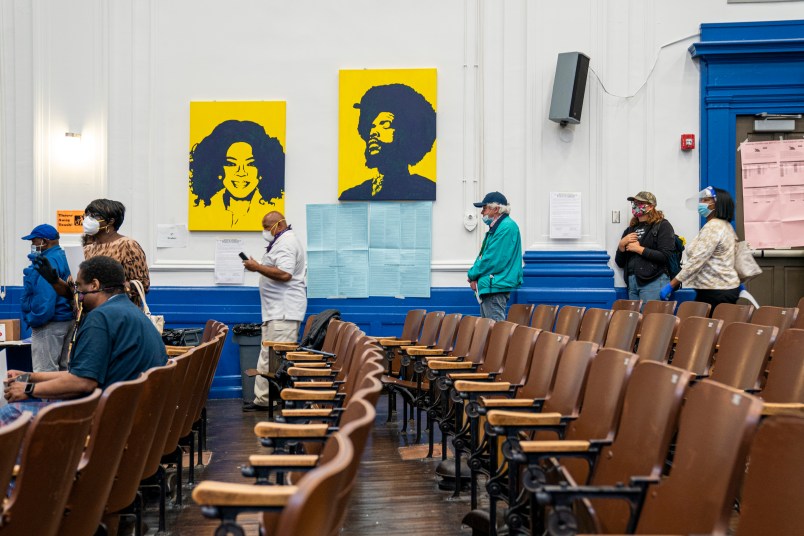Hispanic and Black voters in a Philadelphia County requested mail ballots on average several days later than their white counterparts during the primary, according to an internal analysis by a voting rights group.
Later application submissions, in turn, decreased the likelihood that those ballots were returned, the Pennsylvania chapter of All Voting Is Local found.
Altogether, the group’s research from the June primary reinforced the need to close the education gap surrounding vote-by-mail, All Voting Is Local’s Pennsylvania director Scott Seeborg told TPM.
“This shows a need for a way more robust and ground level community education effort,” Seeborg said.
The group found similar trends in Allegheny County, which is home to Pittsburgh, though Allegheny had a higher rate of absentee ballots that were requested and ultimately returned.
The use of vote by mail in the state has skyrocketed this year. Even before the pandemic, Pennsylvania election officials were already preparing for an uptick because of a 2019 law change that removed the state’s excuse requirements for absentee voting.
The June 2 primary over-performed, by several times, those initial expectations.
Nonetheless, Black and Hispanic communities sought to use vote by mail at lower rates than white areas of Philadelphia, the All Voting is Local analysis found, and there was also a gap between white and Black communities in Allegheny County.
“Rich and whiter areas were requesting and returning more absentee ballots. Black, lower income, and areas with more people age 18 to 24 were requesting and returning fewer ballots,” the analysis said. All Voting Is Local shared its analysis with TPM on the agreement that it not be published in full.
The group compared census tract data with state information about absentee voting in the primary, meaning use rates were derived from total population rather than number of registered voters.
Seeborg pointed to a number of factors that could explain why communities of color were less likely adopt the practice.
“Philadelphia … has had an extremely strong history of in-person voting,” he said, particularly among the Black community.
“The introduction of the pandemic created a lot of uncertainty, and that uncertainty was combined with this push to do vote by mail, because the tool was so new,” he said.
One key question is whether delays in ballots being delivery were hampering the use of vote by mail among people of color, given the trend of Black and Hispanic voters submitting their requests later on average than white voters.
In Philadelphia, requests from Black and Hispanic voters were on average received by election offices 10 days later than those from white voters, who on average got their requests in by May 2.
“For Black and Hispanic voters who decided to apply for an absentee ballot, 50% had not done so by May 18 and 19 respectively,” the analysis said. “That means about 50% of Black and Hispanic applications came with less than two weeks before Election Day.”
The average submission date gap between Hispanic and white voters was much less pronounced in Allegheny County, but still Black voters submitted their requests six days later on average than white voters, who on average submitted their request by May 5.
A “sizable portion” of voters who applied to vote by mail on May 19 or later did not ultimately submit those ballots, the analysis said.
About 40 percent of Allegheny County residents who applied to vote absentee within that period did not submit those ballots, while that rate was 30 percent in Philadelphia County.
Seeborg told TPM that, beyond the need for more education around vote-by-mail, the research highlights the need for making in-person voting and drop boxes for absentee ballots widely accessible this fall, even as more people than ever choose to vote absentee. He also called on legislators to allow for voters to drop off mail ballots at in-person election sites.
“The pathway to victory, if you will, on getting the ballot in was really narrow” in the primary, Seeborg said, particularly as the civil unrest at the time of the early June primary made Philadelphia’s in-person voting sites and drop boxes less accessible.







And yet, when my SO contacted the Leigh County Board of Elections to find out why the application she submitted online 2 weeks ago has not yet been approved, she was told that they will not begin to process the requests until September 14.
Racism in the US deeply permeates our institutions and our peoples.
This is no surprise really. Most Black people distrust American institutions for very, very good reasons. If you’re used to voting in person and have never voted by mail, it only makes sense that you might be leery of doing something different. With an election as dire as this one, I don’t blame anyone who feels the need to go cast their vote in person just to be sure their vote counts.
I’m voting in person. Wear a good mask, carry hand sanitizer, keep your distance, wait in line, sanitize hands, use voting machine, sanitize hands, go home, take off mask, wash hands. How to avoid infecting yourself and others is doable and well established.
Special cases aside, if you can go to grocery store or go to the post office or stop by at work to pick up stuff or have friends over for dinner, you can vote in person.
Low income, marginalized folks are often occupied with day to
day, pressing concerns. Compounded by sub-optimal high school
graduation rates, incarcerated family members, and the impact
of severe chronic stress which detracts from personal efficiency,
and contributes to depleting health issues. When such issues
abound it is tough to complete a variety of forms let alone
devote half of a day to voting in person.